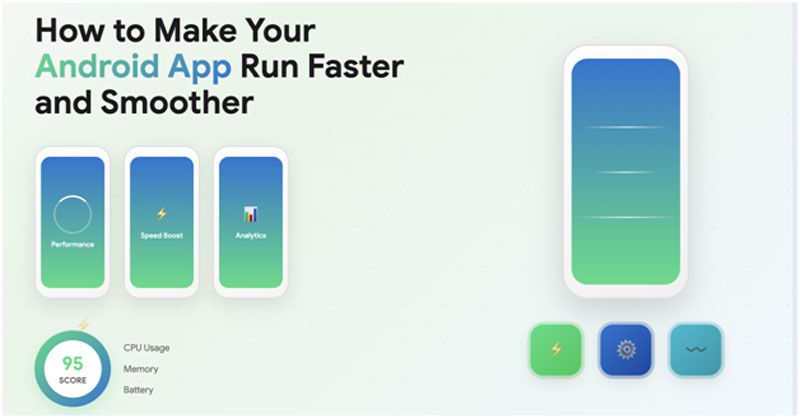Do you know that more than 65% users close the website application due to slow loads, which impacts loss in business opportunities, and it also affects visibility, where Google prioritizes faster experiences in mobile search. So it’s better to keep checking the website application frequently to improve the weak points. If you’re still confused about how you can make your Android app run faster and smoother, let’s get further the top 10 tips to improve how to make apps load faster in 2025.
Tips and Tricks to improve Android app performance
The smarter and smoother the app performance, the more it competes in the market environment. So without wasting any time, let’s grab tips and tricks to improve Android app performance.
1. Reduce the app size
Before a user starts using your app, they will first see the MBs your app is considering. If your app requires 100-200 MB, then users may avoid downloading the application. Storing more MBs can impact your app size and increase load times to open.
So, avoiding these scenarios, you can have some tips for reducing application size;
- Use Android App bundles, which primarily focus on smaller app sizes, more efficient distribution, and flexible sizes.
- Prefer SVGs, as they can scale without actually affecting the quality.
- Remove unused resources such as images, videos, or text files.
- Remove unused code or unnecessary XML files.
2. Optimize Networking
Always prioritize texts over images, as we know image loads take more time to load, which slows the networking speed of applications. It’s better to go for text written formats, avoid images and videos.
3. Optimizes Images and Videos
Do you know that user engagement is higher when your apps consider images and videos? To enhance your application, integrate some of the photos and videos that are supported with less storage. Where users don’t have to face any slower load time problems.
Using WebP and SVGs (scalable vector graphics) is technically used for a more streamlined process, but WebP takes extra effort to create images, which also results in the best outcomes.
4. Optimize Screen Size
Screen sizes have created a lot of buzz around developers they face difficulties and challenges in it. Due to we have so many Android and iOS device users, with different screen phone sizes, developers face challenges in making.
Here are some tips to optimize screen size;
- Use view dimensions so that you can resize the layout.
- Implement the bitmaps to scale the views
- Build a flexible and adaptive UI
- Develop an alternative UI
- Provide a small-width qualifier
- Modularize fragments with UI components
5. Optimize offline mode
Optimizing offline mode is a crucial factor in mobile applications, for more user engagement, especially in areas where there is limited connectivity in area. With this feature, users can interact and fetch information even when they are is no connectivity of internet connectivity. This results in enhanced user experiences, productivity, and improved app usage.
6. Improve Memory Usage
Memory usage is the most crucial factor in mobile app development. Because in the initial building stage of the application, developers mostly focused on features and avoided the usage of memory. This impact app crashes and frustrates users.
Things to watch when dealing with memory issues;
- Use tools like AndroidProfile to prevent unwanted leaks
- Do not use third-party libraries until it’s necessary
- Review your memory usage
- Avoid tight coupling
- Regularly review your codebase to identify any memory leaks
- Use primitive data types when possible
7. Scale down the app launch time
In a crowded app market, a fast and responsive app stands out. Optimizing launch time provides a competitive edge, attracting and retaining users who value efficiency.
8. Hit a Smooth frame rate
A steady frame rate of 60 FPS (frames per second) or higher is necessary for the utmost user experience in mobile applications. A good frame rate guarantees smooth animation and sudden responses to touch, making everything feel responsive. This results in less lag time and less frustration for users.
9. Work Efficiently with trends
Based on our experience track records of mobile application development, one of the secrets to optimizing an Android is the way you work on its threads. If your developers are well known about how and where to use threads. They can easily build high performance without any crashes.
There are mainly two types of threads: one is the primary thread or UI thread, and the one is the secondary or background thread. If you make any changes to UI threads with load streams or images, or access to local or remote servers, it will obstruct the main thread. And until the ongoing task is done, you can’t assign it to another call or method.
10. Identify the latency killers
Latency issues could be serious concerns for your app. Latency can cause critical errors and sometimes crash the whole app. You can avoid these scenarios by limiting the third party latency sources and cutting down the requirement for latency killer APIs you may use on your smartphone.
Conclusion
App performance is a crucial factor in increasing business growth and bringing more user engagement to the applications. Ignoring can impact it negatively with poor user experience, and poor ratings on the Google Play Store or app store. If you spend some time following the above points, you can ensure that your app can run smoothly and has great reviews.

Reblog It collaborates closely with clients to develop tailored guest posting strategies that align with their unique goals and target audiences. Their commitment to delivering high-quality, niche-specific content ensures that each guest post not only meets but exceeds the expectations of both clients and the hosting platforms. Connect with us on social media for the latest updates on guest posting trends, outreach strategies, and digital marketing tips. For any types of guest posting services, contact us on reblogit.webmail[at]gmail.com.
